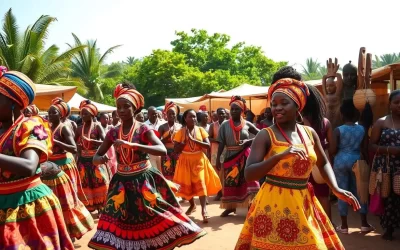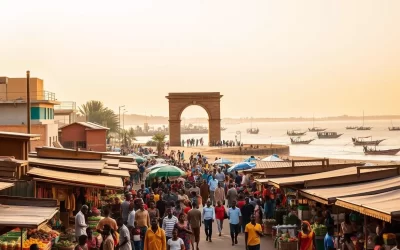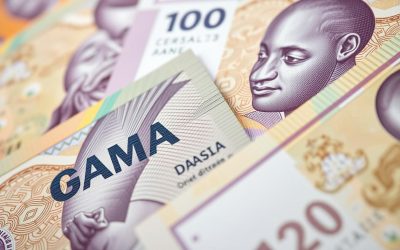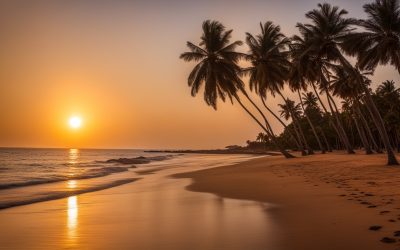Ever thought about how a small West African nation speaks so many languages? In Gambia, language diversity is more than just a fact. It’s a key part of the country’s culture and history.
The Gambia is a unique place where many languages live together. English is the official language, but there are also many local languages. These languages tell stories of tradition, migration, and survival.
In Banjul’s busy streets and in rural areas, Gambian languages show off the culture. Each language has its own beat, history, and importance. Together, they make up a special way of communicating that shapes the nation’s identity.
Key Takeaways
- English serves as the official language in Gambia
- Mandinka is spoken by 38% of the population as a first language
- At least four primary tribes contribute to the linguistic diversity
- Most Gambians are bilingual due to extensive English education
- Indigenous languages reflect rich cultural heritage
Introduction to Gambia’s Linguistic Landscape
Gambia, in West Africa, is a lively place where many languages come together. It has about 1.9 million people. Here, languages show the rich culture of the country.
The mix of languages in Gambia is interesting. English is the official language, but many ethnic languages are also spoken. Exploring Gambian communication shows a complex web of words and meanings.
- Mandinka: Over 38% of the population’s first language
- Fula: Spoken by approximately 21% of inhabitants
- Wolof: First language for about 18% of Gambians
- English: Official language with limited native speakers
In cities like Banjul, the language scene is even more vibrant. For example, in Serekunde, about 70% of people speak Wolof. This shows how Wolof is important in urban areas.
“Language is the road map of a culture. It tells you where its people come from and where they are going.” – Rita Mae Brown
Learning about Gambia’s languages is more than just about talking. It helps us understand the country’s social life, history, and culture. Each language has its own stories of community, tradition, and strength.
The Role of English as the Official Language
The English language is very important in The Gambia’s identity. It connects the country’s past with its present. Since 1965, The Gambia has kept English as its official language. This shows the lasting impact of British rule.
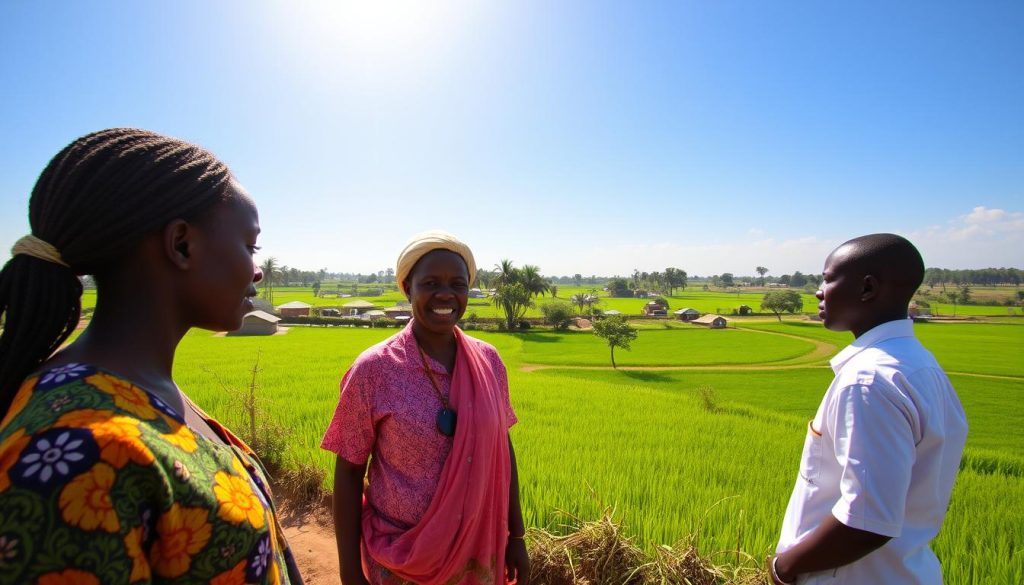
Historical Colonial Influence
British rule deeply shaped The Gambia’s language. Keeping English as the official language was a choice that honored the past. This choice has helped in many ways:
- Preservation of administrative systems
- Educational infrastructure development
- International communication capabilities
Current Usage in Education and Government
Today, English is the main language in schools and government. This choice helps in many areas:
- Standardized national communication
- Enhanced international diplomatic relations
- Broader economic opportunities
English Proficiency Levels
Even though English is official, not everyone speaks it well. The level of English varies:
| Population Segment | English Proficiency |
|---|---|
| Urban Areas | High |
| Rural Communities | Moderate to Low |
| Government Employees | Advanced |
English’s role in The Gambia is complex and interesting. It connects the country’s past with its present. English is key in The Gambia’s social and professional life, even if it’s not everyone’s first language.
Mandinka: The Most Widely Spoken Indigenous Language
The Mandinka language is a key part of Gambian culture. It connects people in The Gambia and other countries. About 1.3 million people worldwide speak it, making it very important for communication.
Learning about Mandinka shows us a lot about Gambian society. It’s spoken by over 38% of the population. This language is more than just a way to talk; it’s a part of the culture.
“Language is the road map of a culture. It tells you where its people come from and where they are going.” – Rita Mae Brown
- Geographic Spread: Mandinka is spoken across multiple West African countries
- Cultural Importance: Central to traditional storytelling and community interactions
- Linguistic Characteristics: Features 10 vowels in its western dialect group
The Mandinka language is very flexible. People use different writing systems, like:
- Arabic-based Ajami script
- Latin alphabet for school
- NKo alphabet, created in 1949 for writing
| Language Characteristic | Details |
|---|---|
| Native Speakers | 1.3 million globally |
| Dialect Groups | Western and Eastern variants |
| Writing Systems | Arabic, Latin, NKo alphabets |
Mandinka is easy to understand with other dialects. It’s used in music, celebrations, and daily talks. This language shows the rich culture of The Gambia.
Wolof Language and Its Urban Influence
The Wolof language is a powerful force in cities like Gambia and Senegal. It has about 7.1 million native speakers and 16 million who speak it as a second language. This makes Wolof a key way to communicate.
In Banjul, the capital of Gambia, Wolof is the main language. About 75% of the city’s people use Wolof every day. This shows how important it is for culture and social ties.
Geographic Distribution
Wolof is spoken in many places. It’s not just for one ethnic group:
- Almost every regional capital in Senegal uses Wolof.
- It’s common in cities like Dakar.
- More than 80% of Senegal’s people speak Wolof.
Cultural Significance
Wolof is more than a language. It’s a symbol of culture and tradition. Cultural preservation is key in Wolof, seen in:
- Traditional tea ceremonies (àttaaya)
- Musical styles like mbàllax
- Oral storytelling
Usage in Daily Life
Wolof is used in many ways. It’s used in everyday talks and business talks. Young people mix Wolof with French, English, and Arabic, making the language lively.
Wolof is not just a language; it’s a living, breathing cultural expression that connects people across social boundaries.
Exploring Banjul or Senegal’s cities? Knowing Wolof lets you connect with the culture and people on a deeper level.
The Fula Language Community
Explore the lively world of the Fula language, a key part of Gambia’s language mix. It’s the third most spoken indigenous language in the country. Fula links communities across West Africa with its deep cultural roots.
The Fula language has about 6.3 million native speakers. In Gambia, around 21% of people speak Fula as their first language. This makes it a vital way for many communities to communicate.
“Language is the road map of a culture. It tells you where its people come from and where they are going.” – Rita Mae Brown
Linguistic Characteristics of Fula
- Contains 28 known dialects that are mostly mutually intelligible
- Uses a unique base-five counting system
- Has a complex grammatical structure with 21 noun classes
Regional Distribution
| Country | Fula Speaker Percentage |
|---|---|
| Gambia | 21% |
| Senegal | 22% |
| Guinea | Significant Presence |
The Fula language shows the changing face of Gambia’s language scene. Its speakers keep their cultural identity strong while joining the country’s diverse language society. Fula is important in both traditional and modern settings, helping to keep culture alive.
Minority Languages and Their Preservation
Gambia is home to many languages beyond the well-known ones. These minority languages are key to keeping the country’s culture alive. They show the rich diversity of smaller ethnic groups in Gambia.
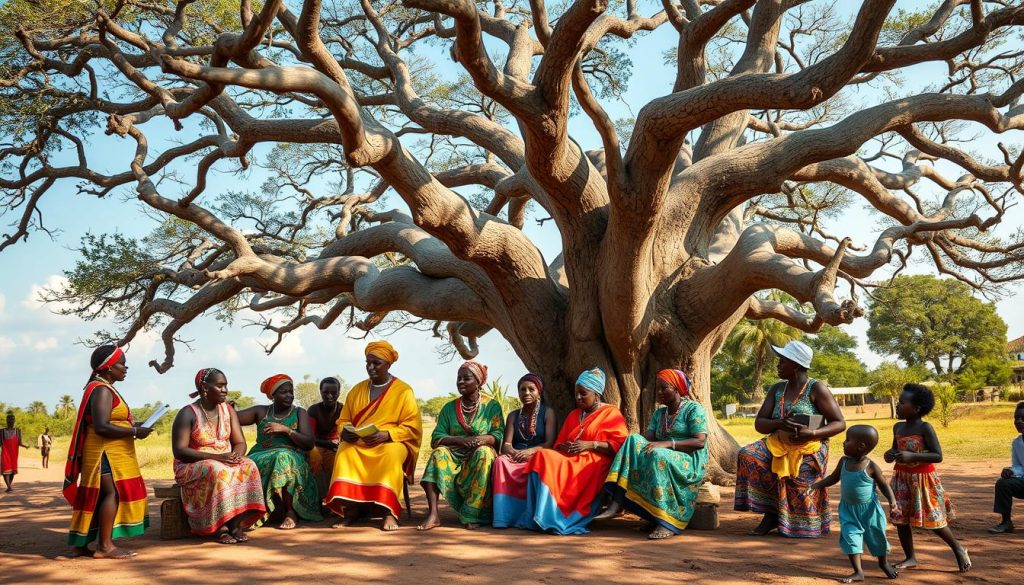
Keeping these languages alive is a big job. It needs the hard work of the community and awareness of their importance. Many face big challenges in keeping their languages alive in today’s world.
Serer Language
The Serer language has a long history. It’s spoken by a proud community. They keep their culture alive through:
- Oral storytelling traditions
- Community gatherings
- Intergenerational knowledge transfer
Jola Language
Jola is another vital minority language in Gambia. Its speakers have found creative ways to keep their language alive, such as:
- Local language education programs
- Cultural festivals celebrating linguistic heritage
- Community-based language documentation efforts
Other Indigenous Languages
Gambia also has many other indigenous languages. These languages are vital for the country’s cultural richness.
| Language | Estimated Speakers | Primary Region |
|---|---|---|
| Serer | Approximately 1,000-5,000 | Coastal regions |
| Jola | Around 5,000-10,000 | Southern Gambia |
| Other Indigenous Languages | Varied small populations | Various regions |
“Language is the roadmap of a culture. It tells you where its people come from and where they are going.” – Rita Mae Brown
Protecting these minority languages is a big task. It needs the effort of both the government and local communities. Your support is crucial in keeping these languages alive for the future.
Gambia: Official and Widely Spoken Languages in Education
In The Gambia, English is key in schools and universities. It’s the official language used for teaching. This shows the country’s mix of languages and its history.
The education system in The Gambia is very diverse. Besides English, students learn national languages. This helps them keep in touch with their culture. Schools use creative ways to help students learn, no matter their language background.
- English is used for official government documents
- National languages taught include Wolof, Pular, Mandinka, Serer, and Jola
- Multilingual classrooms employ teachers who can communicate in multiple languages
A study showed that teaching in national languages helped kids. They got better at reading English. This method helps kids learn and keeps their cultural roots alive.
| Language | Percentage of Population |
|---|---|
| Mandinka | 38% |
| Pulaar | 21% |
| Wolof | 18% |
| English | 0.5% |
“Language is the roadmap of a culture. It tells you where its people come from and where they are going.” – Rita Mae Brown
Alliance Francaise and private teachers offer more language learning. They give lessons that fit around students’ schedules. This helps people learn local languages.
The Gambian way of teaching shows how to use English well. At the same time, it keeps the country’s rich language traditions alive.
Language Distribution Across Different Regions
Gambia’s languages show a complex mix of communication styles. These styles change a lot from city to countryside. The country’s language map is shaped by history, culture, and social factors. These factors influence how people talk and express themselves.
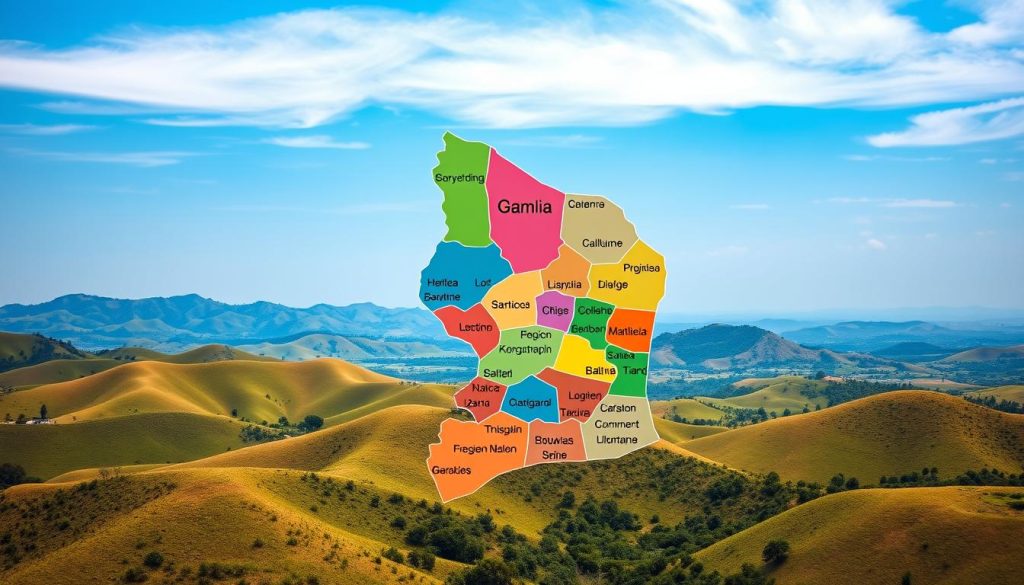
In cities like Serekunde, language patterns are special. For example, Wolof has become a key language for everyone. Amazingly, 70% of Serekunde’s people can speak or understand Wolof, even though there are not many ethnic Wolof there.
Urban Language Variations
Urban areas in Gambia are known for their language flexibility. The main languages work together in a lively way:
- Wolof is key in business and social talks
- English is the official language for government and schools
- Mandinka keeps its cultural importance
Regional Language Patterns
Each part of Gambia has its own language preferences:
- Mandinka is spoken by about 42.3% of the people
- Wolof is common in city business areas
- Fula is found in rural and farming areas
“Language is the roadmap of a culture. It tells you where its people come from and where they are going.” – Rita Mae Brown
Rural areas have a more traditional language scene. Indigenous languages hold deep cultural values. Each area has its own story of communication, showing the rich linguistic diversity of Gambia.
The Impact of Multilingualism on Gambian Society
Gambia’s society is a colorful mix of languages, deeply influencing its national identity. Most people in Gambia speak at least two languages fluently. This richness in languages brings unique social interactions that go beyond just talking.
Being multilingual in Gambia has many benefits. It helps people think more flexibly and solve problems better. It also improves their understanding of different cultures and opens up more job opportunities.
- Enhance cognitive flexibility
- Develop stronger problem-solving skills
- Improve cultural understanding
- Create expanded economic opportunities
“Language is the roadmap of a culture. It tells you where its people come from and where they are going.” – Rita Mae Brown
SIL Africa’s detailed studies of languages in Gambia showed complex patterns in communities. In 617 schools, they found students often speak languages not from their ethnic group. This shows how fluid Gambia’s language scene is.
| Language Skill | Percentage of Population |
|---|---|
| Bilingual Proficiency | 65% |
| Trilingual Capability | 35% |
| English Proficiency | 45% |
The language connections in Gambia help build a shared identity among different ethnic groups. Knowing multiple languages is a key to fitting in and understanding cultures in this vibrant society.
Language Preservation Efforts and Cultural Identity
The Gambia’s language is a key part of its culture. It’s not just about saving languages; it’s about keeping a society’s spirit alive.
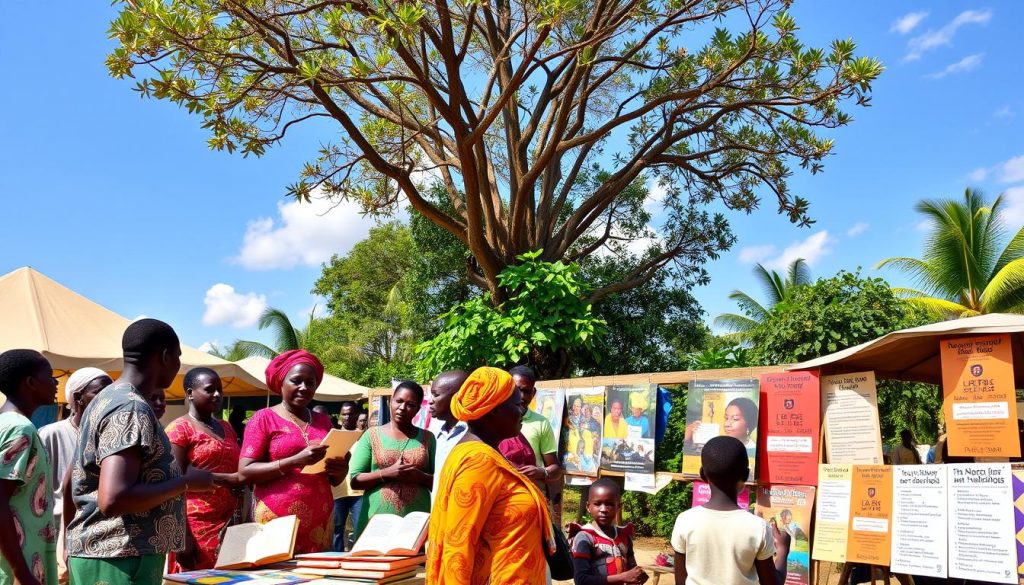
In The Gambia, language and culture are closely linked. About 80% of Gambians think losing languages would harm cultural values. This shows how important language is to a community’s identity.
Government Preservation Initiatives
The Gambian government is working hard to save languages:
- They document native languages.
- They support projects to document languages.
- They use local languages in media.
- They create educational programs to teach languages.
Community-Led Language Protection
Local communities are also key in saving languages. They run programs like:
- Language classes for kids.
- Cultural festivals to celebrate languages.
- Storytelling in native languages.
“Language is the roadmap of a culture. It tells you where its people come from and where they are going.” – Rita Mae Brown
These efforts are paying off. Studies show a 60% rise in cultural activities when native languages are used. By saving languages, The Gambia keeps its culture alive and vibrant.
Modern Language Trends and Future Outlook
The language scene in Gambia is changing fast. It shows the complex mix of languages in a multilingual society. With over 2 million people and many indigenous languages, the country is at a key point in language diversity.
New trends in language show big changes in how people talk. Technology and global connections are changing how Gambians use language. Social media and mobile phones are making new places for language blending.
- Increasing digital communication platforms
- Growing influence of global languages
- Youth-driven language innovations
- Preservation of indigenous language elements
The younger people are leading the way in language change. They mix traditional languages like Wolof, Fula, and Mandinka with English. This creates new ways of speaking that show off Gambia’s rich culture.
“Language is the roadmap of a culture. It tells you where its people come from and where they are going.” – Rita Mae Brown
Despite challenges, there’s a strong push to keep language diversity alive. Schools and community groups are working hard. They aim to save indigenous languages while also embracing new ways of talking.
Gambia’s language future looks bright and full of possibilities. The mix of old and new languages will keep the language scene lively and flexible.
Conclusion
Your journey through Gambia’s linguistic landscape shows a rich cultural mosaic. The nation’s many languages highlight its dynamic identity. With eight major ethnic groups, Gambia shows how language goes beyond words.
English is key in this complex world, acting as an official language. It coexists with indigenous languages like Mandinka and Wolof. Gambian English, part of the Outer Circle of World Englishes, shows the country’s history and adaptability.
Language in Gambia is more than just a tool for communication. It’s a living story of cultural strength. From Mandinka griots to urban Wolof speakers, each language tells its own tales. Language connects communities and keeps Gambia’s rich heritage alive.
Exploring Gambia’s languages gives us a peek into its social fabric. The ability of different groups to communicate through many languages shows the country’s unity and adaptability. This is especially true in today’s changing world.
The above is subject to change.
Check back often to TRAVEL.COM for the latest travel tips and deals.
Here are some Tours & Sightseeing suggestions that might pique your interests!

